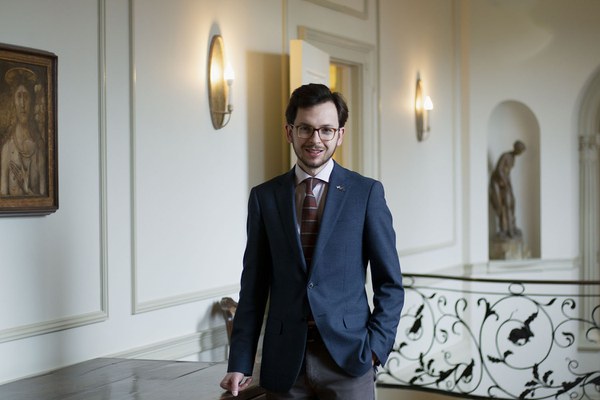Alasdair Grant, who submitted his PhD at the University of Edinburgh in June, was a spring 2020 junior fellow in Byzantine Studies. His research report, “Cross-Confessional Captivity in the Later Byzantine World, ca. 1280–1460,” delved into how different religious groups interacted in the later medieval Mediterranean.
Q&A with Alasdair Grant
Why is the captivity and slavery of Byzantine peoples understudied?
There were slaves in the Byzantine Empire, but in the fourteenth and fifteenth centuries, the big story is actually in the other direction—the people who were being taken out of the Byzantine Empire and ending up in places all across the Mediterranean. They were captured in the Aegean region (modern-day Greece and western Turkey) and used for a range of types of labor or to raise money from their ransom. They were transplanted as far west as Catalonia or Majorca or to a Venetian-ruled area like Crete. These people were dislocated in one cultural context and mixed up in a new one.
Such cultural and religious mixing is as interesting as the economic role these people might have played. Part of the reason this hasn’t been looked at in such detail before is because it requires you to take in evidence external to what we think of as late Byzantine studies. It involves bringing together documents in Latin, Greek, and a handful of other languages like Arabic. People who have studied slavery in Byzantine contexts tend to focus on Greek-language documents, where there is a comparative lack of evidence. What I mainly look at are records of financial transactions preserved in archives in Italy, Spain, and Croatia. By and large, I find references to people who were Greek, recorded in texts that are not in Greek.
What has your research revealed about the lives of these captive people?
I focus on establishing information about one individual from one single piece of documentation, then amassing all those individual references into what I’m calling a casebook—outlined biographies of people. At the moment, I’m working with a data set of around 1,500 individuals from Latin notarial documents. There are references to additional people I haven’t been able to see: for example, a record of 766 Greeks captured by the navy of the Genoese admiral Paganino Doria in 1351–1352.
One interesting trend occurs because Greeks enjoyed preferential status among unfree populations in several places. I think mitigating legislation arose because people recognized it was hypocritical to capture and enslave Greeks while working toward reuniting the churches in Constantinople and Rome and planning a crusade that would help Byzantium.
So we start to see cases where people try to disguise the fact that an unfree person was Greek in order to ensure that person didn’t receive preferential treatment. For example, in Castellbisbal in Catalonia in the early fifteenth century, a man called Georgius petitioned the king, claiming a man called Dalmat had kept him chained for seven years to try to force him to say he was a “Saracen” (probably a North African Muslim here) and his slave. Once in writing, that would be hard to argue against.
There was a very big 1380 case from Famagusta, Cyprus, of someone called Caly. Her owners claimed she was a Tatar (so from north of the Black Sea) bought as a slave. But she claimed she was actually a wrongfully enslaved Greek from Constantinople. The whole case hung on her perceived ethnic identity, since slave-owning Christians assumed or liked to think Tatars weren’t Christian (even though they sometimes were) and so were enslavable by Christians.
These are examples of people receiving better or worse treatment depending on whether they were identified as being from one group or another. Not all 1,500 cases give you such information. But here we know more about how political and racial attitudes in this period affected the fates of these people, how these cultures interacted in very complex and changing ways.
How does your work change our understanding of Byzantine geography?
The project explodes our sense of how big the late Byzantine world was. The overwhelming narrative of the late thirteenth through fifteenth centuries is one of shrinkage and decline: political and economic contraction, territory lost to the nascent Ottoman Empire, trade monopolized by the Italians. We think of the Byzantine world in this period as basically being Constantinople, Thessaloniki, and a little slice of the Peloponnese.
Now, if you study captives, you see an enormous diasporic population from Iberia to the Levant, including the major islands and the European coast of the Mediterranean, and potentially Egypt to some small degree. The project encourages us to look further afield than the small Constantinopolitan intellectual elite, which I think tends to dominate late Byzantine studies. It’s been great having fruitful discussions on these topics, for example with fellow Costas Constantinides and visiting scholars Anthony Kaldellis and Dimiter Angelov.
Julia Ostmann is postgraduate writing and reporting fellow at Dumbarton Oaks. Photo by Elizabeth Muñoz Huber, postgraduate digital media fellow.

